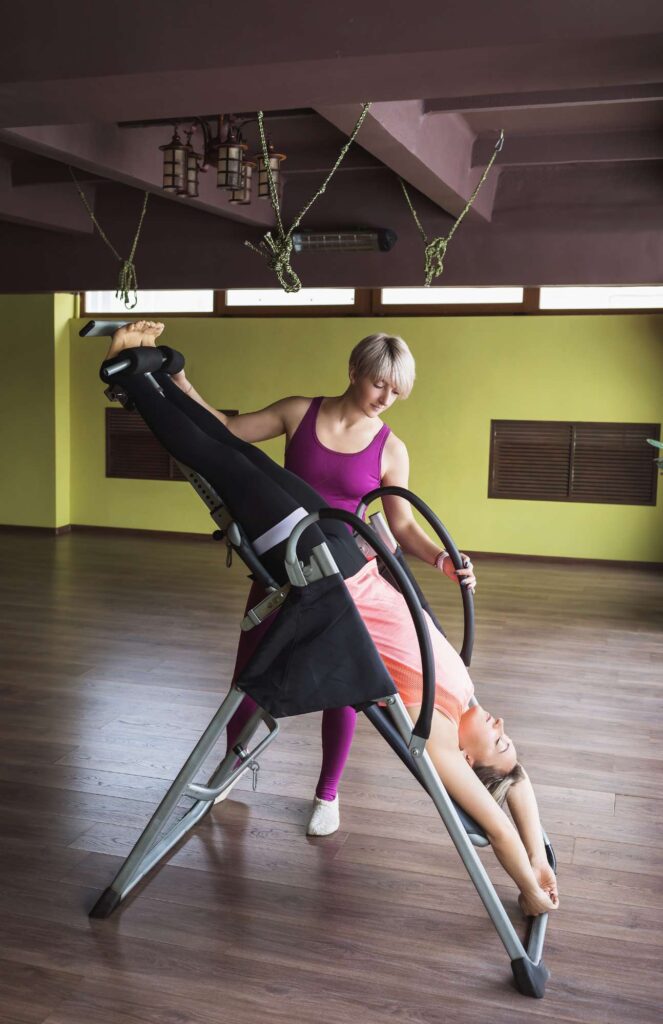Ultimate Guide to Spine Decompression Exercises
Do you ever feel like you need someone to stretch your spine? As a chiropractor, I understand the impact it can have on everyday life. In my quest for relief, I’ve delved into the world of spine decompression exercises and discovered their transformative benefits.
In this comprehensive guide, I will share insights into spine decompression exercises, their benefits, common causes of spine compression, and specific exercises for lower back and neck pain.
We will also explore how these exercises can improve mobility, the equipment needed, and how to incorporate them into your daily routine. Additionally, I’ll provide guidance on seeking professional help to maximize the effectiveness of these exercises.
Table of Contents
Understanding Spine Decompression Exercises
Spinal decompression exercises are a vital component of holistic care for those experiencing spine compression. These exercises work by alleviating pressure on the vertebrae, discs, spinal cord and surrounding structures, promoting spinal realignment and relieving discomfort.
The goal is to create space between the vertebrae, allowing for improved circulation, reduced nerve impingement, and enhanced mobility.
Engaging in spine decompression exercises can help counteract the effects of gravity and poor posture, both of which contribute to spinal compression. These exercises are designed to gently stretch and elongate the spine, providing relief from the compressive forces that can lead to pain and limited mobility.
By understanding the principles behind spine decompression exercises, individuals can take proactive steps to manage their spinal health and overall well-being.
Amid the myriad of exercise options available, it’s a good idea to choose those specifically tailored to decompress the spine. These exercises should target the upper, middle, and lower regions of the spine, ensuring comprehensive relief and support.
Whether you’re dealing with localized discomfort or seeking to prevent future spine compression, incorporating these exercises into your routine can yield significant benefits.

Benefits of Spine Decompression Exercises
The advantages of spine decompression exercises extend far beyond immediate pain relief. By regularly engaging in these exercises, individuals can experience improved posture, enhanced flexibility, and strengthened core muscles.
Decompressing the spine also facilitates nutrient-rich fluids to flow into the spinal discs, promoting their health and resilience.
Furthermore, spine decompression exercises can contribute to better spinal alignment, reducing the risk of degenerative conditions such as degenerative disc disease and enhancing overall mobility.
As the spine experiences less compression, individuals may find that their range of motion and comfort levels improve significantly.
Additionally, these exercises can aid in stress reduction, as the release of tension in the spine often translates to a sense of relaxation and well-being.
By prioritizing spine decompression exercises, individuals can cultivate a foundation of spinal health that supports their overall physical and mental well-being.
These exercises offer a proactive approach to managing spine compression and its associated symptoms, empowering individuals to take control of their health and pursue an active, pain-free lifestyle.
Common Causes of Spine Compression
Understanding the common causes of spine compression is crucial in addressing the root of the issue. Poor posture, prolonged sitting, and repetitive movements can all contribute to spine compression, leading to discomfort and restricted mobility.
Additionally, aging, degenerative conditions, and spinal injuries can exacerbate the compression, resulting in persistent pain and reduced quality of life.
In some cases, underlying conditions such as herniated discs, spinal stenosis, or osteoarthritis can directly contribute to spine compression. These conditions may necessitate a multidisciplinary approach to care, with spine decompression exercises playing a pivotal role in managing symptoms and promoting recovery.
By identifying the specific causes of spine compression, individuals can tailor their exercise regimen and lifestyle choices to address these underlying factors.

Spine Decompression Exercises for Lower Back Pain
Lower back pain is a common manifestation of spine compression, often stemming from prolonged sitting, improper lifting techniques, or muscle imbalances. Targeted spine decompression exercises can provide relief and support for individuals experiencing lower back discomfort.
Exercises such as pelvic tilts, knee-to-chest stretches, and cat-cow poses can help alleviate tension and promote flexibility in the lumbar spine.
Engaging in exercises that strengthen the core abdominal muscles and support proper alignment can also aid in reducing lower back pain. Planks, bird-dogs, and bridges are most effective exercises in stabilizing the lower back and mitigating the effects of compression.
Here is a helpful post about yoga for low back pain and sciatica, specifically.
By incorporating these exercises into a regular routine in the comfort of your home, individuals can work towards strengthening their lower back and minimizing the impact of spine compression on their daily activities.
Spine Decompression Exercises for Neck Pain
Neck pain, often associated with poor posture and sedentary lifestyles, can significantly benefit from targeted spine decompression exercises.
Gentle neck stretches, shoulder rolls, and chin tucks can help alleviate tension and promote relaxation in the cervical spine. Here are a few more handpicked chiropractic neck exercises to help with tightness and discomfort.
Individuals experiencing neck pain can also explore exercises that strengthen the neck and shoulder muscles, such as isometric neck contractions and shoulder blade squeezes.
Experiencing “tech neck?” That is, neck pain related to technology and screens. If you sit at a computer or screen all day, it may be worth while to take a look at these easy tech neck exercises!
By incorporating these key stretches and exercises into their daily routine, individuals can work towards reducing neck pain and improving their overall posture.
Additionally, maintaining ergonomic work environments and practicing mindful movement throughout the day can complement the effects of these exercises, further reducing the impact of spine compression on the neck and upper body.

Spine Decompression Exercises for Improved Mobility
Enhancing mobility is a key objective of spine decompression exercises, as restricted movement often accompanies spine compression. Engaging in exercises that focus on spinal extension, rotation, and lateral flexion can promote a broader range of motion and reduce stiffness in the spine.
Yoga poses such as cobra, child’s pose, and seated twists are particularly beneficial for enhancing spinal mobility and promoting relaxation.
Incorporating dynamic movements that engage the entire spine, such as gentle back bends and side stretches, can also contribute to improved mobility. By prioritizing exercises that encourage fluidity and flexibility in the spine, individuals can work towards reclaiming a sense of ease and freedom in their movements.
This improved mobility not only alleviates the discomfort associated with spine compression but also enhances overall physical function and well-being.
Equipment for Spine Decompression Exercises
While many spine decompression exercises can be performed using only body weight and minimal equipment, certain tools can enhance the effectiveness of these spinal decompression methods.
A yoga mat, exercise ball or foam roller can provide support and cushioning, facilitating comfortable and safe engagement in spine decompression exercises. Additionally, resistance bands and traction devices can be utilized to target specific areas of the spine and customize the intensity of the exercises.
The use of an inversion table can be extremely helpful if you know the proper way to use it. Not only can it be an excellent way to relieve chronic back pain, it can also be used to increase blood flow to support the spinal column along with the intervertebral discs.
Investing in ergonomic furniture, such as supportive chairs and standing desks, can complement spine decompression exercises by promoting proper posture and reducing the risk of further compression.
By creating a supportive environment that encourages mindful movement and spinal health, individuals can optimize the benefits of their exercise regimen and minimize the impact of spine compression on their daily activities.

Incorporating Spine Decompression Exercises into Your Daily Routine
Establishing a consistent routine that incorporates spine decompression exercises is essential for maximizing their benefits. Whether through dedicated at-home exercises or mindful movement throughout the day, individuals can proactively address spine compression and promote spinal health.
Starting the day with some deep breaths, gentle stretches and mobility exercises can set a positive tone for spinal well-being and prepare the body for the demands of everyday activities.
Throughout the day, incorporating posture checks, short stretching breaks, and ergonomic adjustments can complement the effects of structured exercise sessions.
Additionally, integrating spine decompression exercises into existing workout routines, such as yoga or Pilates, can provide a comprehensive approach to spinal health and mobility.
By weaving these exercises into daily habits, individuals can cultivate a resilient and adaptable spine that supports their overall well-being.
Professional Guidance for Spine Decompression Exercises
Seeking professional guidance of a healthcare provider is crucial in navigating spine decompression exercises, especially for individuals with underlying conditions or specific concerns.
Seeking out a physical therapist, chiropractor, or other qualified fitness professionals can provide personalized guidance, ensuring that spinal decompression therapy is tailored to individual needs, pain levels and goals.
These professionals can also offer hands-on techniques for spinal decompression treatment, such as spinal manipulation or manual traction, to complement the benefits of exercise.
Furthermore, individuals with complex spinal conditions, severe pain, persistent symptoms or spinal cord compression may benefit from comprehensive care that includes medical evaluations and imaging studies.
By collaborating with healthcare providers, individuals can gain a deeper understanding of their spinal health and access a holistic treatment plan that integrates spine decompression exercises with other therapeutic modalities.
Professional guidance ensures that individuals can approach spine decompression exercises with confidence and optimize their impact on spinal health.

Conclusion
In conclusion, spine decompression exercises offer a proactive and effective way of alleviating pain and improving mobility for individuals experiencing spine compression.
By understanding the principles behind these exercises, identifying common causes of spine compression, and implementing targeted exercises for lower back and neck pain, individuals can take proactive steps to manage their spinal health.
The benefits of spine decompression exercises extend beyond immediate relief, encompassing improved posture, enhanced mobility, and strengthened core muscles.
By incorporating spine decompression exercises into a daily routine and seeking professional guidance where necessary, individuals can cultivate a resilient and adaptable spine that supports their overall well-being.
With the right exercises, equipment, and mindset, individuals can reclaim a sense of ease and freedom in their movements, minimizing the impact of spine compression on their daily activities.
Ultimately, by embracing the transformative potential of spine decompression exercises, individuals can embark on a journey towards a more active, pain-free lifestyle.
I hope this guide serves as a valuable resource to those seeking relief from spine compression and empowers individuals to prioritize their spinal health.
Remember, your spine is the pillar of your body, and by nurturing it with targeted exercises and mindful practices, you can pave the way for a more vibrant and resilient life.







2 Comments
Comments are closed.